

1 in 5 young people suffer 'extreme cyber-bullying' every day with Facebook accounting for more than half. Ditch The Label report found 70% of youngsters have been cyberbullied Charity surveyed 10,000 13 to 22-year-olds on their experiencesSaid cyberbullying can have a 'catastrophic' impact on their self-esteem Facebook, Ask.fm and Twitter found to be the most likely sources By Becky Evans Published: 07:06 GMT, 2 October 2013 | Updated: 07:56 GMT, 2 October 2013 More than a million young people are subjected to 'extreme cyberbullying' every day, according to the largest ever survey into online abuse.

Social media research raises privacy and ethics issues. Every time you search online for the best restaurant deal, share good news or bad with your Facebook friends, or tweet to your followers, your "audience" is bigger than you know.
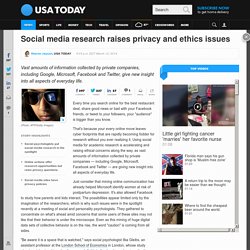
That's because your every online move leaves cyber footprints that are rapidly becoming fodder for research without you ever realizing it. Using social media for academic research is accelerating and raising ethical concerns along the way, as vast amounts of information collected by private companies — including Google, Microsoft, Facebook and Twitter — are giving new insight into all aspects of everyday life. Just consider that mining online communication has already helped Microsoft identify women at risk of postpartum depression. It's also allowed Facebook to study how parents and kids interact. The possibilities appear limited only by the imagination of the researchers, which is why such issues were in the spotlight recently at a meeting of social and personality psychologists.
Facebook Tinkers With Users’ Emotions in News Feed Experiment, Stirring Outcry. Photo To , we are all lab rats.
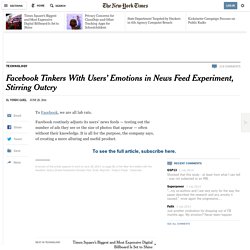
Facebook routinely adjusts its users’ news feeds — testing out the number of ads they see or the size of photos that appear — often without their knowledge. It is all for the purpose, the company says, of creating a more alluring and useful product. Welcome to Forbes. Facebook admits manipulating users' emotions by modifying news feeds. It already knows whether you are single or dating, the first school you went to and whether you like or loathe Justin Bieber.
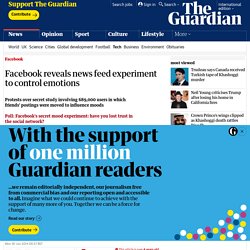
But now Facebook, the world's biggest social networking site, is facing a storm of protest after it revealed it had discovered how to make users feel happier or sadder with a few computer key strokes. Social networking tools and research information systems: Do they compete? Sven Bittner Institute for Research Information and Quality Assurance (iFQ), Godesberger Allee 90, Bonn, Germany.
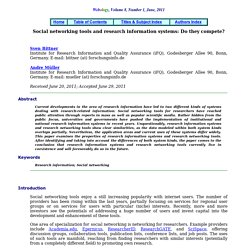
E-mail: bittner (at) forschungsinfo.de Andre Müller Institute for Research Information and Quality Assurance (iFQ), Godesberger Allee 90, Bonn, Germany. E-mail: mueller (at) forschungsinfo.de Received June 20, 2011; Accepted June 29, 2011 Abstract. Welcome to Forbes. Emotional Contagion on Facebook? More Like Bad Research Methods. A study (Kramer et al., 2014) was recently published that showed something astonishing — people altered their emotions and moods based upon the presence or absence of other people’s positive (and negative) moods, as expressed on Facebook status updates.
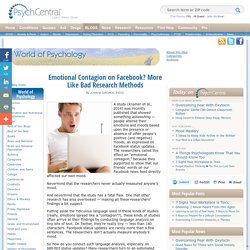
The researchers called this effect an “emotional contagion,” because they purported to show that our friends’ words on our Facebook news feed directly affected our own mood. Nevermind that the researchers never actually measured anyone’s mood. And nevermind that the study has a fatal flaw. One that other research has also overlooked — making all these researchers’ findings a bit suspect. Putting aside the ridiculous language used in these kinds of studies (really, emotions spread like a “contagion”?)
So how do you conduct such language analysis, especially on 689,003 status updates? The first LIWC application was developed as part of an exploratory study of language and disclosure (Francis, 1993; Pennebaker, 1993). Note those dates. Dr. Institutional review board. An institutional review board (IRB), also known as an independent ethics committee (IEC), ethical review board (ERB) or research ethics board (REB), is a committee that has been formally designated to approve, monitor, and review biomedical and behavioral research involving humans.
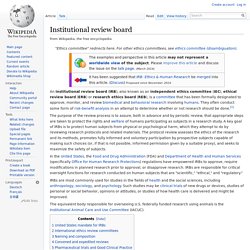
They often conduct some form of risk-benefit analysis in an attempt to determine whether or not research should be done.[1] The purpose of the review process is to assure, both in advance and by periodic review, that appropriate steps are taken to protect the rights and welfare of humans participating as subjects in a research study. A key goal of IRBs is to protect human subjects from physical or psychological harm, which they attempt to do by reviewing research protocols and related materials.
IRBs are most commonly used for studies in the fields of health and the social sciences, including anthropology, sociology, and psychology. United States mandate for IRBs[edit] Naming and composition[edit] Pope, T. Social networking service. A social networking service (also social networking site or SNS) is a platform to build social networks or social relations among people who share interests, activities, backgrounds or real-life connections.

A social network service consists of a representation of each user (often a profile), his or her social links, and a variety of additional services. Social network sites are web-based services that allow individuals to create a public profile, to create a list of users with whom to share connections, and view and cross the connections within the system.[1] Most social network services are web-based and provide means for users to interact over the Internet, such as e-mail and instant messaging. §History[edit] Boyce230Beyon.pdf. Emotional Contagion: A People Pattern Study In 3 Parts.
This is the first in a series of posts responding to the controversial Facebook study on Emotional Contagion The past two weeks have seen a great deal of discussion around the recent computational social science study of Kramer, Guillory and Hancock (2014) “Experimental evidence of massive-scale emotional contagion through social networks” .

I encourage you to read the published paper before getting caught up in the maelstrom of commentary. The wider issues are critical to address, and I have summarized the often conflicting but thoughtful perspectives below. These issues strike close to home, given our company’s expertise in computational linguistics and reliance on social media. In this post, I provide a brief description of the original paper itself along with a synopsis of the many perspectives that have been put forth in the past two weeks. The study was published in PNAS, and then the shit hit the fan.
The first major criticism is that the study was unethical.